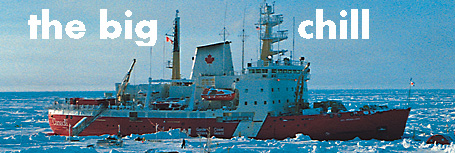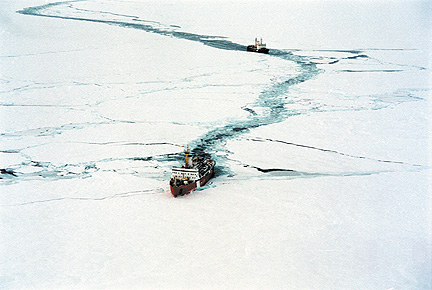

The size and shape of ice floes that make up the pack is one of the missing elements in current models. These systems consider only the total mass or volume of the ice, according to Mike Steele, an oceanographer with the UW's Applied Physics Laboratory and leader of one of the four SHEBA teams trying to improve current models.
Ice floes can be pieces of ice miles in length and width or they can be small enough to kick with your foot, Steele says. Imagine how much faster a field of small floes will melt compared to a field of large floes: The edges of all those small floes will be in contact with the water and, when the wind blows, will grind against each other. If, in coming years, scientists detect a growing number of small floes, we'll need models that can predict how much melting could follow.

The key to tracking this meltdown is to characterize the ice surface and correlate it to ocean and weather conditions. Steele's team is using a satellite and specially developed software to document conditions within 20 miles of the station. Another modeling group, led by Ron Lindsay of the UW's Applied Physics Laboratory, gathers data over a several-hundred-mile area by hitching rides on regularly scheduled flights to and from the station. Lindsay and his colleagues document the ice surface using a video camera, an infrared thermometer and by peering out the windows on both sides of the plane and continuously typing their observations into a laptop.
Flights have been conducted every three, four or six weeks since the station was established. Some scientists remain for only three weeks, others for longer periods, depending on the demands of their particular projects. One American stayed for six months and two Canadians were planning to be at the station for nine.
There's a sign announcing our arrival at the "SHEBA International Airport," but the waiting area of this particular "airport" is a 10-by-8-foot all-weather tent. Our airport limousine is a sled pulled by a snowmobile.
Deposited at the gangway, the Des Groseilliers looms over us, its engines shut off since it was parked in the ice last fall. A deal was struck between U.S. research agencies and the Canadian Department of Fisheries and Oceans to use the icebreaker that includes opportunities for Canadian biologists to work at the station.
We're welcomed aboard by the ship's officer logistique, a member of the Des Groseilliers French-Canadian crew. There's a form requiring our signatures and rooms to be assigned but first, he says, lunch is served.
After polishing off a bowl of homemade soup and a lobster salad, I'm thinking they should publish a SHEBA cookbook. Good food is important when meal times give everyone a break from the alternately hectic/monotonous pace at the station. Besides, people can burn 5,000 calories a day, about triple the norm, when winter temperatures dip as low as -45F and the wind blows, often at speeds above 10 knots.
Besides being a hotel for sleeping and eating, the Des Groseilliers has been a safe haven when Mother Nature has decided to "break camp." In part because of this year's major El Nino event, the five- by-six-mile floe carrying the station moved unusally fast. It was shoved along a haphazard, 800-mile path in its first eight months of operation, ending up 400 miles northwest of where it started.
Along with moving the ice floe, sometimes at a rate of 20 miles a day, the wind and ocean currents have rearranged the station itself a number of times. During blizzard conditions in early April, the part of a camp with a 70-foot meteorological tower and seven huts migrated a quarter mile away from the ship--overnight.
In another part of camp, it took a mere 15 minutes for two pieces of ice to come together with enough force to push up a ridge 10 feet tall and 35 feet wide. Teetering half off that ridge were tents housing three snowmobiles. With the ice about to bury the huts and vehicles, the crew sprang into action using ropes, pulleys and muscle-power to ease the snowmobiles to the ground, according to UW's Andy Heiberg, head of logistics.
Heiberg's 27 years of polar work has included running numerous ice camps, learning to expect the unexpected and repeating the mantra, "You've got to be flexible."
Among other things, the logistics team is responsible for keeping the airstrip open and power supplied to huts, overseeing station safety and managing the shipping of cargo and people to-and-from the station. The team includes a number of longtime Applied Physics Laboratory employees and some more-recent hires. Between them the team has more than 85 years of experience working in the Arctic.
Dangers Include Polar Bears and Ice Break-Ups
Total Meltdown? Ice Cap Future in Question
Send a letter to the editor at columns@u.washington.edu.